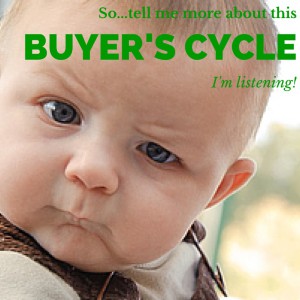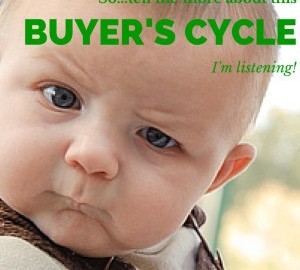 By Nancy Lambert, Published November 7, 2014
By Nancy Lambert, Published November 7, 2014
In part one of this article I talked about the importance of developing buyer personas to help understand what triggers your buyers to start researching solutions to a problem.
By understanding the steps your buyers take in their decision-making process you can more effectively move your prospects through the sales funnel and turn them into qualified leads.
But that’s just the beginning. There are still a few more things you need to do before publishing your work.
Have the Right Content for Each Stage of the Sales Funnel
Where your potential customers are in their buying cycle will determine the type of content they need. For instance, the content used to make them aware of your products and services tends to be different from the content that will turn them into buying customers.
That’s why you need different types of content for each stage of the buyer’s cycle.
Here’s what a typical buyer’s cycle looks like:
- Awareness – your potential customer becomes aware that they have a need or issue that needs to be fixed.
- Research/Education – your potential customer starts researching online to educate themselves on how they can get their problem solved.
- Comparison/Validation – your potential customer has identified options and solutions that may meet their needs and is reviewing products and companies that may work.
- Purchase – your potential customer is ready to make a decision to buy (and hopefully they choose you!)
Auditing the Content You Already Have
As you consider all of the new content you may need to develop for each stage of the buyer’s cycle, it can be overwhelming. But it doesn’t have to be. Think about the arsenal of content that you probably already have available to you that can be reworked and repackaged.
That’s where a content audit comes in –and it’s relatively easy to do.
First, you need to collect all of the content that has already been created for your business such as blog posts, presentations, brochures, proposals, whitepapers, etc. Then, organize and catalog it by content type, topic, buyer persona, the date you created it and the number of leads/customers it generated for you.
From there, start analyzing to see if you have enough content that you can rework and use that will fit your various buyer personas, and if it’s working (or not).
Content audits are great because they encourage you to tap into content resources you might already have and lets you know where to focus your creative content efforts next.
Content Mapping
Remember, all content is not created equal. There are certain types that will be best suited for each stage of the buyer’s cycle.
Research has shown that specific pieces of content come into play depending on where your ideal customer is in their buying cycle.
Here is a typical way to map your content to the buying cycle:
Awareness: Blog posts and social media updates
Research/Education: Ebooks, webinars, industry reports
Comparison/Validation: Case studies, demos, customer testimonials
Purchase: Analyst reports, detailed product information
Time To Get Started
So, you know who your prospective customers are, how they become motivated, what actions they take to get their needs met, and the stages of the buying cycle they go through. Now you can focus on creating (or re-purposing) content that not only speaks to their needs but drives them to your company to get their needs met.
I hope you’ve enjoyed this two part series. You can get even more information on how to implement an Inbound Content Marketing plan in your company in this free whitepaper: “8 Critical Ingredients of a Digital Marketing Plan.” This plan delivers practical inbound marketing advice that you can start applying to your business right away.
Business Articles | Business 2 Community
(291)
Report Post




